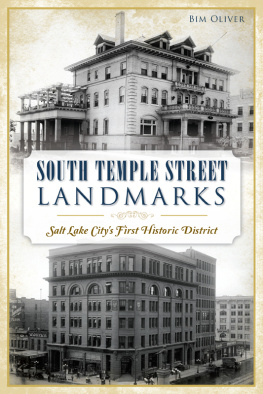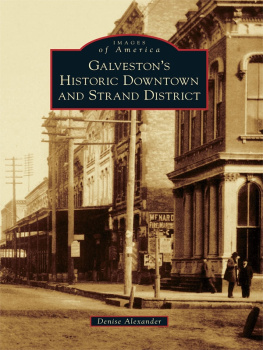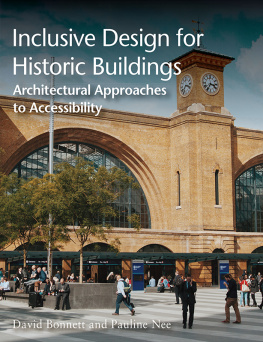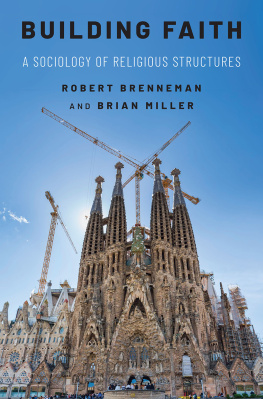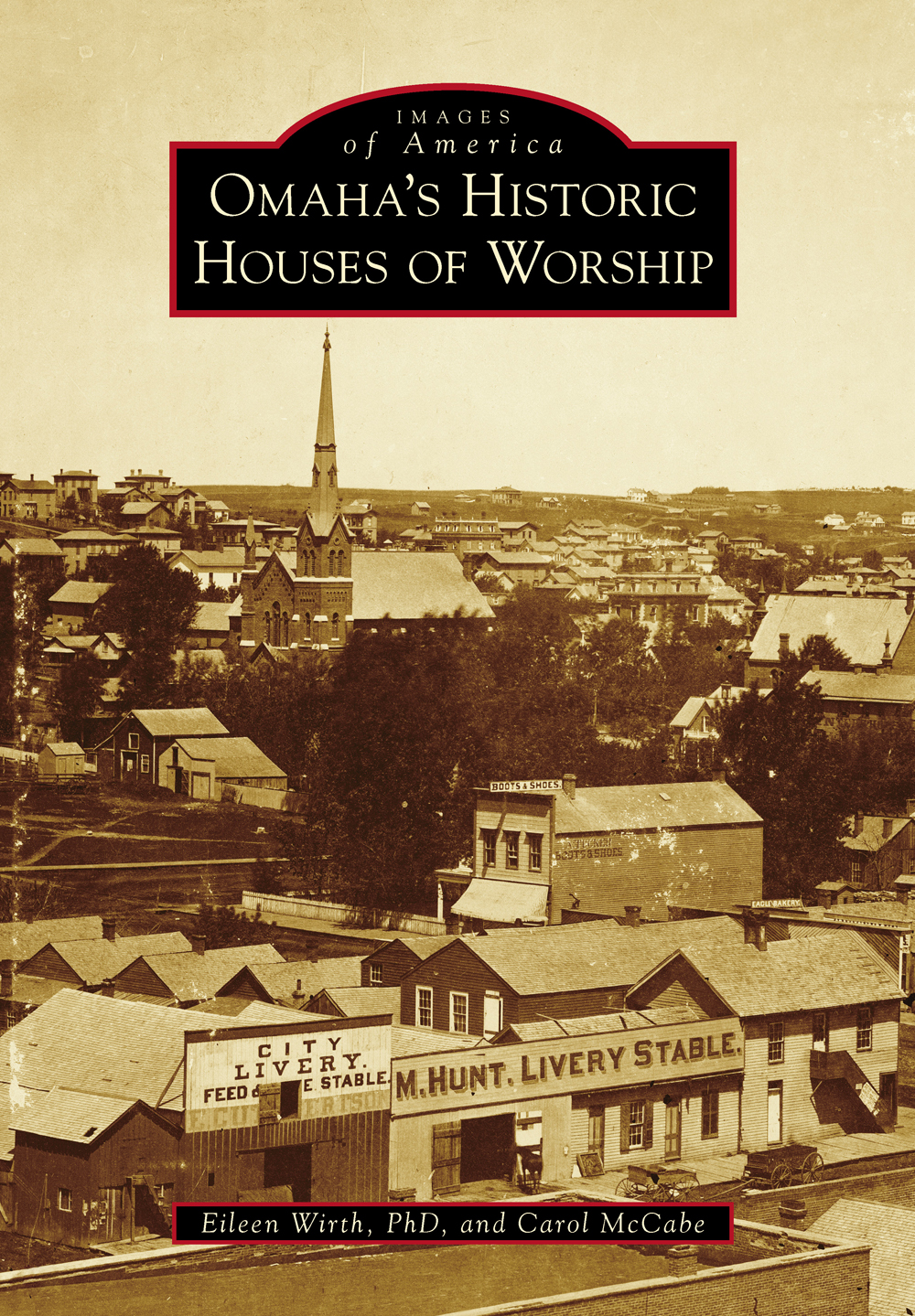
IMAGES
of America
OMAHAS HISTORIC
HOUSES OF WORSHIP
ON THE COVER: By 1876, Omaha was growing into a city that boasted numerous businesses as well as the headquarters of the Union Pacific Railroad. Two years later, Union Stock Yards opened and Creighton University was founded. This photograph demonstrates Omahas rapid growth in less than a decade. (Courtesy of the Omaha Public Library.)
IMAGES
of America
OMAHAS HISTORIC
HOUSES OF WORSHIP
Eileen Wirth, PhD, and Carol McCabe

Copyright 2014 by Eileen Wirth, PhD, and Carol McCabe
ISBN 978-1-4671-1264-2
Ebook ISBN 9781439648087
Published by Arcadia Publishing
Charleston, South Carolina
Library of Congress Control Number: 2014949028
For all general information, please contact Arcadia Publishing:
Telephone 843-853-2070
Fax 843-853-0044
E-mail
For customer service and orders:
Toll-Free 1-888-313-2665
Visit us on the Internet at www.arcadiapublishing.com
In memory of the pioneers who planted the seeds of both faith and tolerance in Omaha, Nebraska.
CONTENTS
ACKNOWLEDGMENTS
We wish to thank many people, religious congregations, and other organizations for their assistance in researching this book and loaning us valuable historical photographs. Everyone we turned to was unfailingly helpful, and we are grateful to all of you. This book is YOURS, although any errors are strictly ours.
We are especially indebted to the Omaha Public Library for supplying us with about half of the photographs and a great deal of caption material, to say nothing of the large amounts of reference assistance. This book literally would not have been possible without the great help of Martha Grenzeback of the local history department. Thanks also to reference librarian Lynn Sullivan, many of whose original captions have been edited or adapted for this text. Her research is reflected on countless pages of this book. Special thanks also to library director Gary Wasdin for his support and flexibility, which allowed this project to proceed.
While a great many of Omahas historical congregations contributed heavily to this book, we are especially grateful to the Rev. Michael Gutgsell, pastor of St. Cecilias Cathedral, and development director Beth Klug for allowing us to use the amazing photographs of the cathedral that Al J. and Ione Werthman shot for the parishs 75th-anniversary book. Material for captions for our extensive St. Cecilias section also came from that book.
Here is a list of other congregations and organizations that contributed photographs and information to this book: First United Methodist Church, St. Mary Magdalenes Church, Kountze Memorial Lutheran Church, Trinity Episcopal Cathedral, Creighton University and archivist David Crawford, First Central Congregational Church, First Unitarian Church, Clarkson College, Sacred Heart Catholic Church, St. Johns Greek Orthodox Church, Temple Israel, First Baptist Church, First Presbyterian Church, Boys Town, the Jewish Federation of Omaha and its wonderful library, the Douglas County Historical Society, and Finegold Alexander + Associates Inc., Architects. We apologize for not naming the individuals connected with all these groups who assisted us, but you know who you are!
Special thanks to Vera Mercer for the use of her scanner and other assistance, and to the staff of Arcadia Publishing for inviting us to do this project and assisting us through the process.
INTRODUCTION
From todays dazzling Omaha Riverfront area, with its parks, hotels, bars, restaurants, arena, and pedestrian bridge to Council Bluffs, it is hard to envision the location as a muddy village clinging to the banks of the Missouri River in the 1850s. Indeed, drinking, gambling, and other vices were so prevalent that a Kansas City newspaper once suggested that the nation pray for Omaha.
In todays Omaha, it is hard to drive six blocks without seeing a house of worship of some variety. It is estimated that more than half of the population belongs to a congregation, which is higher than the national average. Many of both the historic and new houses of worship offer visual hints to the cultures of the people who built them.
Who would expect to see an elephant atop a Hindu temple or Orthodox cupolas in a Midwestern city? For that matter, how did one of the nations 10 largest cathedrals come to be built in a city that had less than 200,000 people at the time construction began?
This book explores the fascinating story of how these and many other religious buildings and related landmarks came into being. It takes readers on a photographic tour of Omahas historic houses of worship, including tales of the people and groups that built them. Although many early Omaha congregations came and went and some preachers gave up on the community, church steeples began to dot the downtown Omaha landscape a few years after its founding in 1854.
Early Omahans established a religious culture that endures to this day. From the first, the city was religiously diverse, and this is reflected in the wide range of historic church buildings depicted in this book. No one faith dominated, although Roman Catholics were, and remain today, the largest religious group.
Because Omahas settlers were diverse and had to find a way to live together, they tended to be religiously tolerant. Until churches could be built, for example, Catholics, Episcopalians, and Methodists all held services in the territorial capitol building. After Catholics built the citys first church, they shared an organ with the Episcopalians who met in a nearby commercial building. Men from the two congregations carried it back and forth weekly. This spirit of cooperation has endured.
The historic houses of worship featured in this book also reflect the citys history of immigration, especially in South and North Omaha, where the architectural styles of many churches are physical reminders of the people who built them. South Omaha, especially, features an eclectic collection of churches of many faiths and national heritages, reflecting the diversity of immigrants who came to work in the packinghouses. North Omaha attracted its own diverse collection of African Americans, Irish, Scandinavians, Germans, and Jews, with all of these heritages reflected in historic houses of worship.
This book reflects on the influx of many of these groups into Omaha and the contributions they made by featuring their houses of worship as well as related institutions, such as a small historic Jewish cemetery in North Omaha.
Our work owes much of its inspiration to the late Dr. Charles Gildersleeve, a University of Nebraska at Omaha geography professor who used to fascinate audiences with his slide shows on the citys ethnic landmarks, including religious buildings. He explained that it was possible to trace the movements of various groups around the city by looking at such architectural clues.
As a young religion reporter at the Omaha World-Herald, coauthor Dr. Eileen Wirth developed a special interest in the richness of the citys religious and ethnic heritage and the beauty of many of its historic churches. Coauthor Carol McCabe has deep roots in an ethnically diverse South Omaha family and a special love for this historic part of the city.
Our research included driving the streets of the old neighborhoods of South and North Omaha hunting for historic churches. We scoured books on Omaha history and often stumbled across unexpected treasures or historically interesting tidbits that fleshed out the portrait that began to emerge.
Next page

